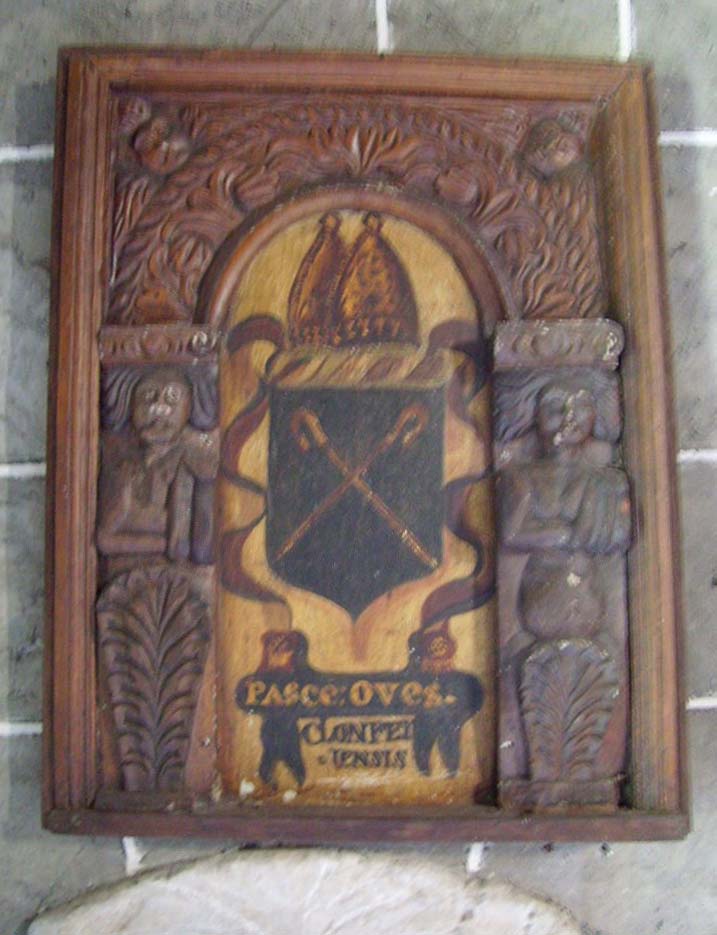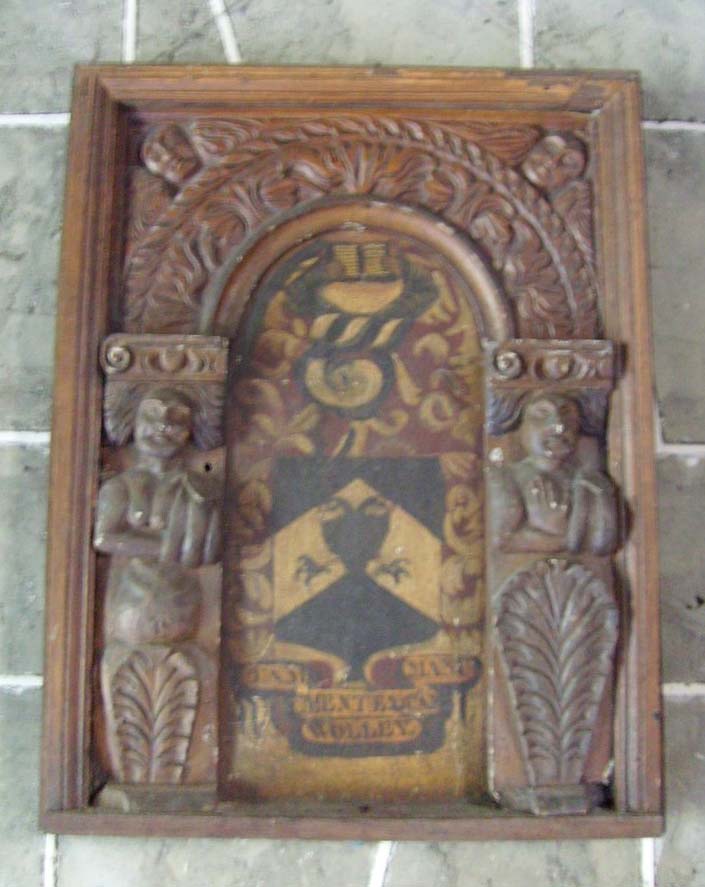© Donal G. Burke 2011
The arms of the Protestant Bishop Wolley of Clonfert are depicted painted on a timber panel surrounded by a heavily carved Jacobean style timber frame incorporating two human figures on either side. The armorial painting is one of a matching pair that hang inside the entrance door of Clonfert Cathedral and are said to have originated in the nearby ruined Bishop’s Palace. Their origin therefrom is confirmed by a late nineteenth century reference by Lord Walter Fitzgerald to the arms of Bishop Wolley ‘painted on the chimney piece’ of the Palace of Clonfert at that time. The other painting depicts the arms of the Bishopric ‘Azure two crosiers in saltire Or’ crowned by a Protestant Bishops mitre and a motto below of ‘Pasce Oves’ and the word ‘Clonfertensis.’ The colours of both panels lie beneath a residue of smoke and grime that render the original colours indefinite.
The arms of the Bishopric of Clonfert
The panel that depicts Bishop Wolley’s arms show a shield of either Sable or Azure upon which is a particularly broad chevron Argent. At the centre of this chevron is placed what appears to be a two-headed eagle Sable or Azure, claws and wings outstretched, the tail of which extends down below the chevron into the base of the shield. Upon a wreath argent and either Sable or Azure are two arms embowed and clothed, with both hands either resting palm downwards on, or holding, an open book, the leaves open to be read by the viewer. Below the shield a scroll bearing the motto ‘Tam mente quam mam’ and below that on a doubled scroll the word ‘Wolley’.
The arms of Bishop Edward Wolley
Born at Shrewsbury in Shropshire, Edward Wolley or Woolley was Domestic Chaplain to both King Charles I and King Charles II. ‘and adhered constantly to them both in their adversity.’ After serving for a time at a rectory in Essex, he was nominated as Protestant Bishop of Clonfert and Kilmacduagh in 1664 by King Charles II. ‘After his advancement he laid himself out on the repairs of the Cathedral of Clonfert,’ according to Sir James Ware, ‘and was at the charges of refounding and rehanging the bell now in the steeple of that Cathedral.’[i] Part of the inscription on this bell read ‘Ope et opere Edwardi Wolley D. Episcopi Clonfertensis et Duaci, Anno Domini 1678.’ In addition to a commemorative verse, the Bishop had a representation of his arms cast on the bell. Lord Walter Fitzgerald, about 1891, described the bell’s episcopal arms as ‘pompously quartered with a spread eagle fancifully adorned with the heads of chubby-cheeked cherubs.’[ii] The spread eagle was evidently a representation of that eagle from Bishop Wolley’s own arms. Lord Walter Fitzgerald opined that the last two words of the commemorative verse; ‘Probasti me,’ which he translated as ‘Thou hast tried me,’ may have been Bishop Wooley’s motto, but it would appear his motto was that given on the scroll in the painted panel.
He remained as Bishop until his death in 1684. On his death the Protestant see fell vacant until 1690.
[i] Sir James Ware’s History of the Bishops of the Kingdom of Ireland, Dublin, 1739, p.644
[ii] Vigors, Col. P.D. (ed.), Report for the Year 1891 of the Fund for the Interpretation of the Memorials of the Dead, Ireland, 1893, Dublin, printed at the office of the ‘Irish Builder,’ p. 368; Macalister, R.A.S., The Dominican Church at Athenry, J.R.S.A.I., Vol. III, No. III, 1913, p. 210. Sir James Ware’s History of the Bishops of the Kingdom of Ireland, Dublin, 1739, p.644



